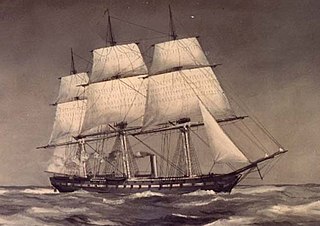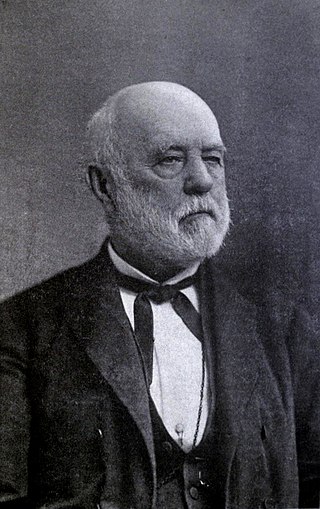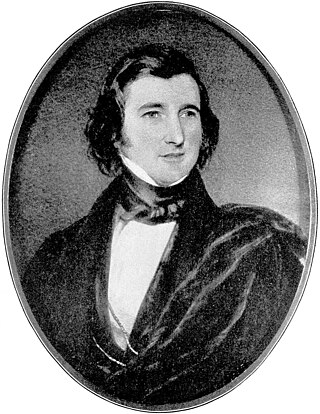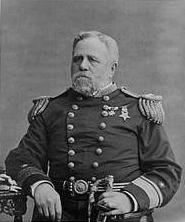Related Research Articles

USS Wabash was a steam screw frigate of the United States Navy that served during the American Civil War. She was based on the same plans as Colorado. Post-war she continued to serve her country in European operations and eventually served as a barracks ship in Boston, Massachusetts, and was sold in 1912.

Rear Admiral Christopher Raymond Perry Rodgers was an officer in the United States Navy. He served in the Mexican–American War, the American Civil War, as superintendent of the Naval Academy, president of the United States Naval Institute, and commander-in-chief of the Pacific Squadron.

Elisha Kent Kane was a United States Navy medical officer and Arctic explorer. He served as assistant surgeon during Caleb Cushing's journey to China to negotiate the Treaty of Wangxia and in the Africa Squadron. He was assigned as a special envoy to the United States Army during the Mexican–American War and as a surveyor in the U.S. Coast Survey.
Sir Alexander Armstrong was an Irish naval surgeon, explorer, naturalist and author. After obtaining a medical degree he joined the Royal Navy and was stationed on board HMS Investigator, tasked with finding the lost expedition of explorer Sir John Franklin. Investigator was trapped in the ice at Mercy Bay in 1851 and Armstrong spent several winters in the Arctic before he returned to London.

William Maxwell Wood was an officer and surgeon in the United States Navy in the middle 19th century. He became the First Surgeon General of the U.S. Navy in 1871, with the equivalent rank of commodore. He rose to president of the examining board in 1868 and chief of the U.S. Navy Bureau of Medicine and Surgery in 1870 following his service in the American Civil War as Fleet Surgeon of the North Atlantic Blockading Squadron aboard the USS Minnesota and Medical Officer of the James River Flotilla, participating in several famous Naval battles, and establishing temporary hospitals as needed during the Civil War.

William Samuel Waithman Ruschenberger was a surgeon for the United States Navy, a naturalist, and an author.

John Kearsley Mitchell was an American physician and writer, born in Shepherdstown, Virginia. Orphaned at the age of eight, and sent to his late father's family in Scotland at the age of thirteen, Kearsley was educated at Ayr Academy and the University of Edinburgh.

William Paul Crillon Barton, was a medical botanist, physician, professor, naval surgeon, and botanical illustrator.

Thomas Harris was a U.S. naval officer. He served as the second chief of the Bureau of Medicine and Surgery.

Thomas H. Cripps was a native of Philadelphia, Pennsylvania, who became a U.S. Medal of Honor winner during the American Civil War. While serving in the Union Navy as a quartermaster aboard the USS Richmond, he operated one of that's ship's guns under heavy enemy fire for two hours during the Battle of Mobile Bay, Alabama on August 5, 1864, helping to damage the CSS Tennessee and destroy artillery batteries of the Confederate States Army at Fort Morgan, even as the enemy's shell and shot damaged his ship and killed several of his fellow crewmen. For those actions, he was awarded his nation's highest honor for bravery on December 31, 1864.

Ninian Pinkney, also spelled Pinckney, was a United States Navy surgeon and medical director. He graduated from St. John's College, Annapolis, Maryland, in 1829, and from Jefferson Medical College, Philadelphia, Pennsylvania, in 1833. He spent his entire naval career helping to develop the field of surgery and medicine. He was especially prominent—and praised—during the American Civil War.
James Martin II was a native of Ireland who served in the U.S. Marine Corps during the mid-19th century. Rising up through the ranks from private to sergeant while fighting for the federal government of the United States (Union) during the American Civil War, he displayed conspicuous bravery on August 5, 1864, while serving aboard the USS Richmond. Operating one of that ship's guns under heavy enemy fire for two hours during the Battle of Mobile Bay, Alabama, he helped to damage the CSS Tennessee and destroy artillery batteries of the Confederate States Army at Fort Morgan, even as the enemy's shell and shot damaged his ship and killed several of his shipmates. In recognition of his gallantry, he was presented with the Medal of Honor, the United States' highest award for valor, on December 31, 1864.

Rear Admiral Henry Kuhn Hoff was a United States Navy officer. During his long career, he took part in combat in Sumatra and in the American Civil War.

Rear Admiral Charles Carroll Carpenter was an officer in the United States Navy. He participated in the African Slave Trade Patrol, fought in the American Civil War, served as commander of the Asiatic Squadron, and was recalled to duty briefly during the Spanish–American War.

Captain Robert F. R. Lewis was an officer in the United States Navy. He participated in the Paraguay Expedition, fought in the Mexican War and American Civil War, and served briefly as commander of the Asiatic Squadron.
Rear Admiral Andrew Bryson was an officer in the United States Navy. He fought in the American Civil War and served as commander of the South Atlantic Squadron.

Rear Admiral George H. Cooper was an officer in the United States Navy. During his long naval career, he served on the African Slave Trade Patrol, and fought in the Second Seminole War, the Mexican War, the American Civil War, and the Korean Expedition, and rose to command of the North Atlantic Squadron.

John Cummings Howell was an officer in the United States Navy during the American Civil War. He rose to the rank of rear admiral and late in his career was commander-in-chief of the North Atlantic Squadron and then of the European Squadron.

Phineas Jonathan Horwitz was an American surgeon.
References
- ↑ The Descendants of Jonathan Kearsley, 1718-1782, and His Wife Jane Kearsley, 1720-1801, (from Scotland), Elmer L. White, 1900, p. 38-9
- ↑ Historical Sketch of Geological Explorations in Pennsylvania and Other States, J. P. Lesley, Harrisburg, Pennsylvania: Published by the Board of Commissioners for the Second Geological Survey, 1876, p. 102
- ↑ "A Canoe Expedition Into the Everglades in 1842", George Henry Preble, United Service, A Quarterly Review of Military and Naval Affairs, April 1883, p. 358-376
- ↑ https://oceanexplorer.noaa.gov/history/docs/vicissitudes.html 1852: Vicissitudes of Ocean Exploration
- ↑ Commissioner of Patents Annual Report (1860), Patent Office, 1861, p. XLIII
- ↑ "Applications for Extension", Scientific American, May 24, 1874, p. 332
- ↑ Register of the Commissioned, Warrant, and Volunteer Officers of the Navy of the United States, United States Navy, U. S. Government Printing Office, 1875, p. 143
- ↑ Catalogue of Birds Collected by A. A. Henderson, M.D., U.S. Navy, at Hakodadi, Island of Jesso, Japan, John Cassin, Proceedings of the Academy of Natural Sciences of Philadelphia, Vol. 10 (1858), pp. 191-212
- ↑ "Notes on Synentognathous Fishes", Henry W. Fowler, Proceedings of the Academy of Natural Sciences of Philadelphia, Volume 71 (1919), p. 9.
- ↑ The Descendants of Jonathan Kearsley, 1718-1782, and His Wife Jane Kearsley, 1720-1801, (from Scotland), Elmer L. White, 1900, p. 42
- ↑ International Plant Names Index. A.A.Hend.